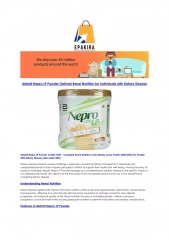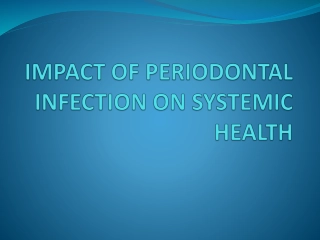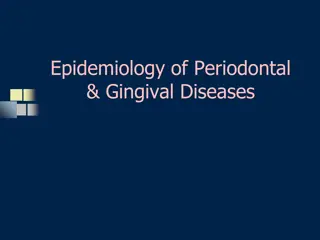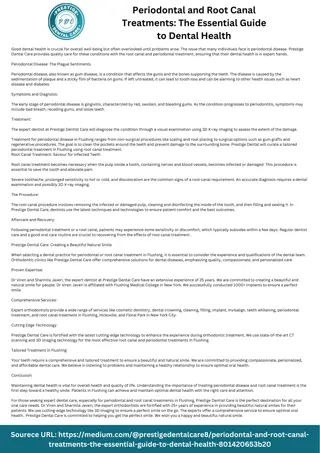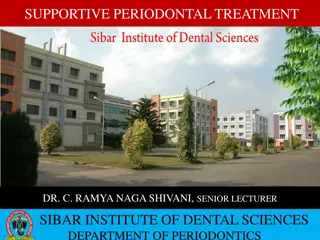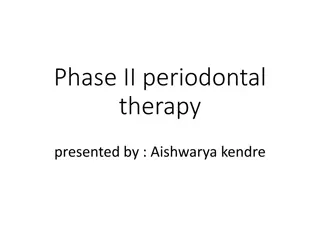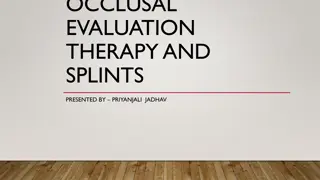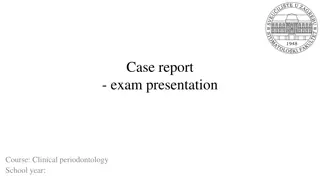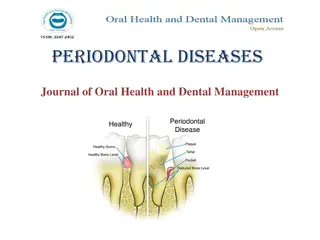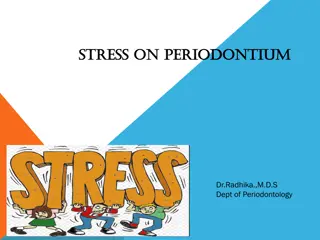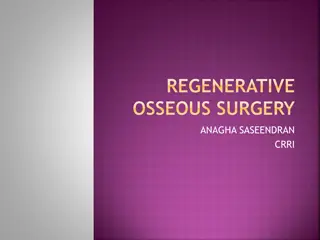Understanding the Impact of Nutrition on Periodontal Disease
Periodontal disease, like caries, is multifactorial and influenced by the balance between bacterial challenge and host defense. Nutritional factors play a subtle but significant role in maintaining periodontal health. A deficiency in nutrients can adversely affect the periodontal tissues and modify the severity of the disease. Nutrients can impact periodontal disease by influencing microbial levels, immune responses, and tissue repair processes. Understanding how nutrition affects periodontal health is crucial for comprehensive dental care.
Download Presentation

Please find below an Image/Link to download the presentation.
The content on the website is provided AS IS for your information and personal use only. It may not be sold, licensed, or shared on other websites without obtaining consent from the author. Download presentation by click this link. If you encounter any issues during the download, it is possible that the publisher has removed the file from their server.
E N D
Presentation Transcript
Nutrition, diet and periodontal disease Dr. Rihab Abdul Hussein Ali B.D.S , M.Sc. , PhD.
Like caries, periodontal disease is an infectious disease, multifactorial in etiology, and occurs when virulence of the bacterial challenge is greater than the host defense and repair capability. Unlike the direct causative relationship between carbohydrates and caries, nutritional factors seem to play a much more subtle role in periodontal status. Even when the periodontium is healthy, there is continual need for nutrients to maintain the tissues. Once inflammation is established, the need for nutrients increases. It is generally acknowledged that gingivitis and periodontitis are the result of accumulation of supra and sub gingival plaque, calculus, or both. However the extent and the intensity of the gingival inflammatory process are directlyaffected by both the virulence of dental plaque bacteria around the supra and sub gingival margin of the teeth and Indirectlyaffected systemically by the relative innate of the periodontal tissue to infection.
The periodontal tissue is composed of epithelium, collagen fiber, blood vessels, cementum and bone so nutritional deficiency will affect adversely these tissues. Nutritional deprivation affect rate and degree of periodontal disease rather than its initiation as nutritional deficiency apparently do not initiate periodontal disease but may modify the severity and extend of the lesion. Over all nutritional deficiency affect the severity and extend of periodontal disease by modulating the responses and repair properties of the tissue. Food and nutrition can affect periodontal disease by: 1- contributing to the microbial in the gingival crevice 2- affecting the immunological to bacterial antigens 3- assessing the repair of the connective tissue at the local site after injury from plaque , calculus and so forth
The mechanisms by which nutrition may affect periodontal disease include the following: Antimicrobial action: many nutrients have antimicrobial activity these may alter the quantity and/ or quality of dental plaque and thus be associated with a reduction in gingival inflammation. Anti- inflammatory effect: nutrient that decrease the host response to injury may result in a reduction in the severity of gingivitis and /or development and progression of periodontitis. These work by affecting the enzymes involved in the production of the anti- inflammatory compounds or by altering which compounds are actually produced.
Immune system modification: (affecting the immunological response to bacterial antigens). Some nutrients are thought to act as immune system modifiers in that they optimize the host immune response so that the protective immune reaction outweigh the self destructive ones, this could also be accomplished by alteration of the permeability of the gingival epithelium thus changing host resistance to bacterial product.
Antioxidant effect: Antioxidants: are substances that protect other chemicals of the body from damaging by reacting with oxidizing agents within the body. The oxidizing agents either are produced within the body as a part of its normal metabolic process or enter the body from atmosphere. For example, free radicals (highly reactive molecules carrying unpaired electron): 1- are producing during the normal oxidation of the energy yielding nutrients in the cell. 2- are produced by the presence in the body from various environmentalpollutants (such as cigarette smoke). When free radicals attack e.g. the lipids of the cell membranes, they can initiate a highly damaging chain reaction leading to widespread damage to the structure.
The intake and serum level of antioxidant nutrients have been associated with reduced risk of many diseased state. Although there is no evidence to suggest that increased intake of these nutrient are associated with a decreased risk of periodontal disease. It is known that several antioxidant nutrient and enzymes are present in the crevicular fluid and in the oral epithelium and secretion considering the responses elicited by the host against pathogenic oral bacteria. Some of the nutrient that influences an individual oxidative status includes vitamin C, vitamin E, zinc, copper, manganese, and selenium. These antioxidant compounds are essential for helping to maintain cell integrity.
Effect of food texture on periodontal health: It has been assumed that firm fibrous food may be beneficial to periodontal health and that eating soft, sticky food might tend to have an adverse effect. These basic tents still seems to have some validity but perhaps for different reasons from those originally suggested.
The following conclusions can be drowning from currently available evidence about the local effect of physical consistency of food on periodontal health: Fibrous food does not remove plaque at the gingival level of the tooth. Chewing on fibrous or firm food stimulate salivary flow and can therefore aid the oral clearance of food debris. Chewing fibrous or firm food dose not increase gingival keratinization but it dose produce a type of local exercise that can stimulate and strengthen the periodontal ligaments and perhaps may also increase the density of alveolar bone adjacent to the root. Another important positive effect of including fibrous food in the diet is that this food can replace empty calorie, sugar rich sweet that are retained in the mouth and may provide a substrate for increased formation of supragingival plaque bacteria.
Nutrition and oral mucosal disease Nutritional deficiencies can impair oral mucosal health and oral immune defense, and component of some diet may be harmful to the mucosa. Conversely, oral disease can interfere with feeding and nutrition as a consequence of compromised mastication and swallowing, pain, or discomfort. Protein-energy deficiency may in children vary in its effect from mild growth retardation to marasmus and kwashiorkor (sever protein malnutrition). Protein malnutrition decreasecollagen synthesis in oral mucosa and oral lesion has been described in kwashiorkor; these include edema of the tongue and papillary atrophy, angular stomatitis, hypo-pigmentation circumorally and xerostomia. Interestingly, tolerance of dentures appears to be increased if the dietary protein intake is improved in edentulous patients.
Common oral mucosal manifestations of nutritional deficiencies: Candidiasis Oral ulceration Glossitis Angular stomatitis Burning mouth syndrome Gingival bleeding Post extraction haemorrhage
Nutrition and oral cancer Oral cancer is largely a preventable disease, dietary factor seems to be important in the prevention of oral cancer, this has been shown in hundred of recent studies. Significant trend of increase risk with more frequent intake of meat and processed meat while significant inverse trend in risk were observed with more frequent intake of fruit and vegetables. Prevention of oral cancer exerted as: Primary prevention focused on elimination of risk factor and inhibition of tumor initiation and activation. Secondary prevention, focused on inhibition of tumor promotion and progression.
Tumor initiation or activation commences when e.g. the DNA of a cell or a population of cells is damaged by exposure to carcinogenic elements, whether endogenous or exogenous if this damaged remain unrepaired then mutation may occur, the sensitivity of the mutated cell to their microenvironment changes and more rapid growth takes place than non- affected cells.
Carcinogenic agents may be of two types: 1- Exogenous agents Physical: ultraviolet rays, gamma rays Biological: viruses Chemical: e.g. nitrosamines, which a class of carcinogenic amine that are form from nitrate and nitrites in food, either during drying and cooking or when the food is in the gastrointestinal tract, also found in cigarette smoke. This nitrosamine is known carcinogens that may be responsible for some cancer. Nitrites are also used as food additives to preserve the color of meat, inhibit oxidation, and discourage the growth of microorganism in meat.
2- Endogenous (normal products of oxidative metabolism that can cause damage to DNA and covert normal cell to cancer cell). Oxygen is essential for sustaining life, but it could be harmful. Oxygen itself is not the problem, but once it transform into a free radicals, it assume a destructive powers. Free radicals are unstable form of oxygen they have lost an electron from their molecular structure, (normally these electron exist in pairs). To replace the lost electron free radicals actively seek out electron from other substances in the body. When these materials give up an electron to the free radicals their structure, become damaged.
Among favorite targets of free radicals are cell proteins, enzymes the fatty acids in cell membrane and the genetic material DNA. Damage to these structures can trigger the development of cancer. A force that acts on oxygen to create free radicals are called oxidative stresses, some of these stresses arise as a normal part of cell reaction.
Fortunately, the bodies are armed with (for example) antioxidants, these substances can neutralize free radicals, and include: 1- Vitamins: vitamin C, E, carotenoids, beta-carotene (provitamin A) 2- Minerals: selenium, manganese, and zinc. Antioxidants tackle free radicals by using a variety of tactics: Giving the free radicals one of its own electron, the antioxidants spares the cell material from damage, antioxidants that work this way are called free radicals scavengers. Vitamin C, beta carotene, and vitamin E work as a scavengers.These antioxidants reducing agents is able to convert these oxidizing agents to harmless substances that can be excreted so scavenge many type of oxidizing radicals
The various antioxidants cooperate with one another to achieve their goals of protection against free radicals damage. They require this team effort because antioxidants exist in different places in the cell and attack different free radicals. Example vitamin C regenerates the reduced form of vitamin E by giving it another electron, once vitamin E losses its electron to a free radicals so converting this vitamin back in to the form in which it act as antioxidants.
Other way antioxidants may protect against cancer by preventing chemicals from being transformed into cancer- causing substances or carcinogens in the first place. For example, vitamin C can stop the transformation of nitrates into powerful carcinogens called nitrosamine but nitrates discourage the growth of microorganism in meats and therefore perform an important function so instead of eliminating nitrates they added vitamin C to these food to prevent their transformation into carcinogenic nitrosamine. It has been found from epidemiological studies that protection against cancer was found among individuals who ate relatively large amount of fresh fruit and vegetables rich in vitamin C. It appears best increase intake of vitamins from food source rather than from large doses of vitamin tablets because benefit can be derived from the cellulose, and from other vitamins, minerals naturally present in the food.
Inhibition of tumor promotion and progression (secondary prevention) Certain antioxidants such as selenium, ascorbic acids and some poly-phenolic compounds found in green tea, fruit and vegetables have been shown to be effective in inhibition of tumor promotion. Vitamin A: large number of retinoid are inhibitors of substances specific to tumor promotion (in the early stage of vitamin A deficiency, change that resemble the early stages of cancer occur in cells.)
The retinoid are powerful antioxidants, protecting cellular lipids from oxidation. In addition, vitamin A direct cells to produce new cells that are identical reproduction of the original, restore normal cell and differentiation (tumor form when new cell that are different from the original cell, begin to reproduce) so they have been used in treatment of cancer, with some success. Vitamin A also boosting immune function, enhances cell mediated immunity and induce a mononuclear infiltrate in the tumor suggesting that immune modulation may be a protective mechanism against the tumor Retinoid are chemoprevention agent for oral pre- malignant lesion, they have significant effect but wide spread use is limited by significant clinical toxicity.
Soybeans It has been suggested that premalignant tumor tissue have elevated level of proteolytic activities that can be used as biomarker for human cancer prevention studies. The Bowman- Birk inhibitor is a soybean derived serine protease inhibitor and a potential chemo-preventive agent for human (potent anti- carcinogenic agent). Interest in use of soy beans products as a cancer preventive agent emanated from epidemiological studies demonstrating low incidence rate of several cancer in population with high soy intake. In Japan, which has a high dietary intake of soy product, the incidence rate of several of cancer is very low.


